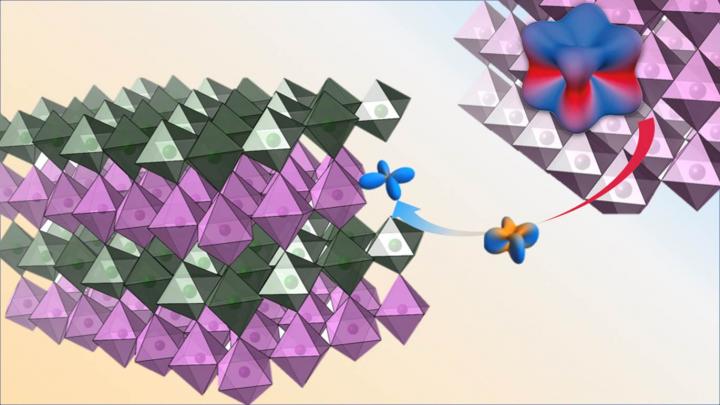Iridium 'loses its identity' when interfaced with nickel

The right side of this image shows a cloud of electrons around an iridium ion. The left side shows an iridium ion interfacing with nickel, where the iridium's shape is strongly altered and its strong spin-orbital interaction effectively 'disappears.' Credit: Fangdi Wen
Hey, physicists and materials scientists: You'd better reevaluate your work if you study iridium-based materials – members of the platinum family – when they are ultra-thin.
Iridium “loses its identity” and its electrons act oddly in an ultra-thin film when interfaced with nickel-based layers, which have an unexpectedly strong impact on iridium ions, according to Rutgers University-New Brunswick physicist Jak Chakhalian, senior author of a Rutgers-led study in the journal Proceedings of the National Academy of Sciences.
The scientists also discovered a new kind of magnetic state when they created super-thin artificial superstructures containing iridium and nickel, and their findings could lead to greater manipulation of quantum materials and deeper understanding of the quantum state for novel electronics.
“It seems nature has several new tricks that will force scientists to reevaluate theories on these special quantum materials because of our work,” said Chakhalian, Professor Claud Lovelace Endowed Chair in Experimental Physics in the Department of Physics and Astronomy in the School of Arts and Sciences. “Physics by analogy doesn't work. Our findings call for the careful evaluation and reinterpretation of experiments on 'spin-orbit physics' and magnetism when the interfaces or surfaces of materials with platinum group atoms are involved.”
Deep understanding of the phenomenon was achieved thanks to state-of-the-art calculations championed by Rutgers co-authors Michele Kotiuga, a post-doctoral fellow, and Professor Karin Rabe.
The scientists found that at the interface between a layer containing nickel and one with iridium, an unusual form of magnetism emerges that strongly affects the behavior of spin and orbital motion of electrons. The newly discovered behavior is important because quantum materials with very large spin-orbit interaction are popular candidates for novel topological materials and exotic superconductivity.
###
The lead author is Xiaoran Liu, a Moore Foundation EPiQS post-doctoral fellow at Rutgers. Rutgers co-authors also include Heung-Sik Kim, Mikhail Kareev, Fangdi Wen, Banabir Pal, Kristjan Haule and Professor David Vanderbilt. Scientists at Lawrence Berkeley National Laboratory, Argonne National Laboratory and Chinese Academy of Sciences contributed to the study. The Gordon and Betty Moore Foundation supported the experimental part of the study.
Media Contact
All latest news from the category: Materials Sciences
Materials management deals with the research, development, manufacturing and processing of raw and industrial materials. Key aspects here are biological and medical issues, which play an increasingly important role in this field.
innovations-report offers in-depth articles related to the development and application of materials and the structure and properties of new materials.
Newest articles

A universal framework for spatial biology
SpatialData is a freely accessible tool to unify and integrate data from different omics technologies accounting for spatial information, which can provide holistic insights into health and disease. Biological processes…

How complex biological processes arise
A $20 million grant from the U.S. National Science Foundation (NSF) will support the establishment and operation of the National Synthesis Center for Emergence in the Molecular and Cellular Sciences (NCEMS) at…

Airborne single-photon lidar system achieves high-resolution 3D imaging
Compact, low-power system opens doors for photon-efficient drone and satellite-based environmental monitoring and mapping. Researchers have developed a compact and lightweight single-photon airborne lidar system that can acquire high-resolution 3D…





















